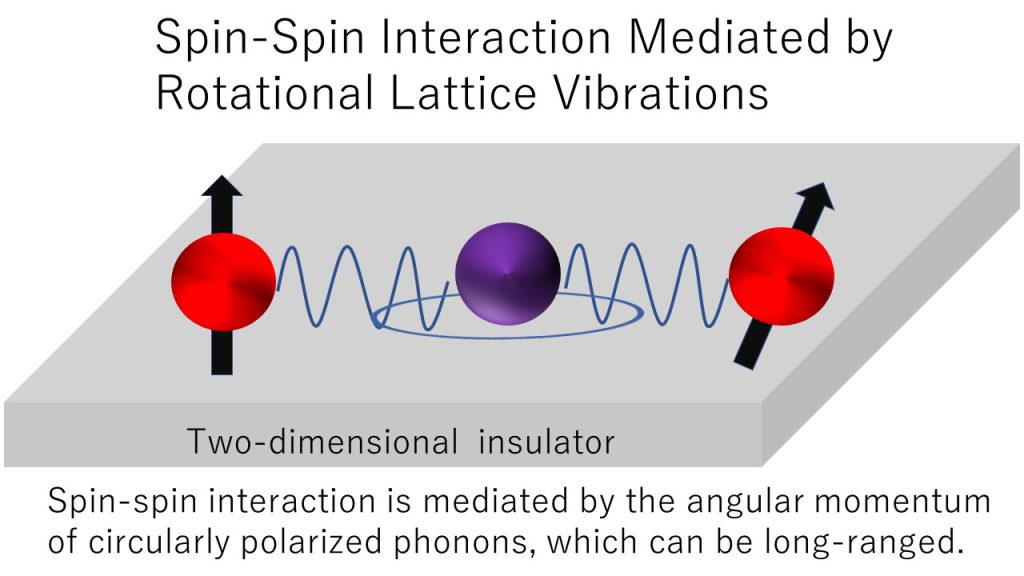Spin-Spin Interaction Mediated by Rotational Lattice Vibrations
© The Physical Society of Japan
This article is on
Spin-Spin Interaction Mediated by Chiral Phonons
(JPSJ Editors' Choice)
J. Phys. Soc. Jpn.
93,
123705
(2024)
.
This study predicts the presence of spin-spin interactions mediated by the angular momentum of lattice vibrations, which can be long-range.

In solids, atoms are arranged in a regular pattern; however, atoms can vibrate from their equilibrium positions through vibrational modes known as phonons. In particular, the circularly polarized vibrational motions of ions are called chiral phonons (note that there is another definition for chiral phonons. In this study, we refer to two-dimensional (2D) rotational phonons as chiral phonons).
Chiral phonons exhibit angular and magnetic moments owing to the rotational motion of the ions. The rotation of the ions also induces effective magnetic fields that can be relatively large (of the order of 1 T). Chiral phonons can couple with spins through the Zeeman effect of these magnetic fields.
Recent experimental reports have suggested that the spin–spin interaction through an insulator is mediated by chiral phonons, which cannot be explained by electronic mechanisms. However, although this interaction may be attributed to chiral phonons, the microscopic mechanism remains unclear. The electronic origins of the mechanisms of spin–spin interactions have been extensively investigated. Thus, one fundamental question is: What is the signature of boson-mediated spin–spin interactions?
To address these problems, we investigated the interaction between two localized spins on top of a 2D insulator in the presence of chiral phonons. We demonstrated that this interaction was mediated by chiral phonons through spin-chiral phonon coupling. The exchange interactions were always positive because of the bosonic nature of phonons. We found that the exchange interactions for acoustic and optical phonons (i.e., in-phase and out-of-phase motions of neighboring atoms) exhibited a power-law decay with respect to the distance between two localized spins and were proportional to the temperature of the system at high temperatures. Furthermore, the chiral phonon-induced spin-spin interaction exhibited a power-law decay, corresponding to the propagation of phonons in insulators. Therefore, this interaction can become the dominant mechanism for spin-spin interactions in magnetic insulators.
Further, an extremely small rotation of atoms can induce a strong magnetic field (on the order of 1 T); therefore, chiral phonons can be regarded as tiny magnets. The interaction between chiral phonons and spin (or magnetization), such as the magnetization reversal induced by chiral phonons, has been actively researched in recent years. Applications to new device principles are anticipated in combination with studies on spintronics.
(Written by T. Yokoyama)
Spin-Spin Interaction Mediated by Chiral Phonons
(JPSJ Editors' Choice)
J. Phys. Soc. Jpn.
93,
123705
(2024)
.
Share this topic
Fields
Related Articles
-
Qualitative Changes in Kinetic Pathways Driven by Hydrodynamic Interactions in Dense Colloidal Suspensions
Cross-disciplinary physics and related areas of science and technology
Statistical physics and thermodynamics
Structure and mechanical and thermal properties in condensed matter
2025-4-18
Even in dense colloidal suspensions, where long-range hydrodynamic interactions are screened, near-field hydrodynamic interactions qualitatively influence the selection of kinetic pathways.
-
Higher-Order Topological Phases in Magnetic Materials with Breathing Pyrochlore Structures
Electronic structure and electrical properties of surfaces and nanostructures
Magnetic properties in condensed matter
Mathematical methods, classical and quantum physics, relativity, gravitation, numerical simulation, computational modeling
2025-4-7
A simple example of a higher-order topological phase, in which the symmetry decreases step-by-step from the bulk to the corner, is realized in a magnetic system with a pyrochlore structure and is characterized by a series of quantized Berry phases defined for the bulk, surface, and edge.
-
Existence of Chiral Soliton Lattices (CSLs) in Chiral Helimagnet Yb(Ni1-xCux)3Al9
Magnetic properties in condensed matter
2025-4-1
Our study examines the magnetic structure of the monoaxial chiral helimagnet Yb(Ni1-xCux)3Al9, providing first direct evidence of the formation of chiral soliton lattice state.
-
Understanding Pressure-Induced Superconductivity in CrAs and MnP
Magnetic properties in condensed matter
2025-3-10
This study reviews existing research on the pressure-induced variation of magnetic properties of transition metal mono-pnictides like CrAS, MnP, and others, aiming to understand the unconventional superconductivity observed in CrAs and MnP.
-
Symmetry and AI: Building the Future of Physics Simulations
Magnetic properties in condensed matter
Measurement, instrumentation, and techniques
2025-2-18
Generative artificial intelligence (AI) has gained considerable attention in scientific fields. By embedding physical symmetry into AI before training, we created a faster and lighter model. Scaling improves the accuracy and unlocks the potential of physics research and applications.




